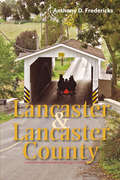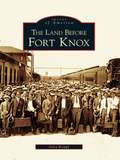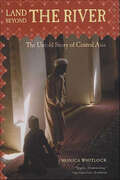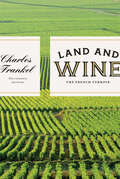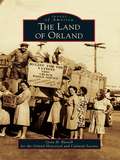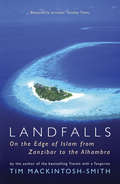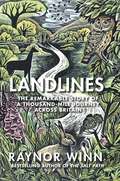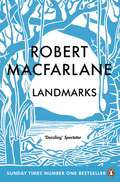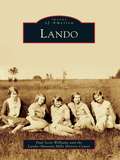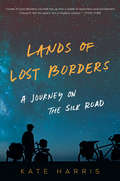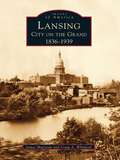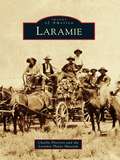- Table View
- List View
Lancaster (Images of America)
by Connie L. Rutter Sondra Brockway GartnerLancaster, Ohio, with a population of around 35,000, sits snuggled among the rolling hills at the base of a sandstone bluff that the Wyandot Indians called "Standing Stone." Just east of the Hock-Hocking River in Fairfield County and a few miles southeast of Columbus, Lancaster was founded on November 10, 1800, by Col. Ebenezer Zane (1747-1811). The city's rich history is celebrated today in one of the most significant historic districts in the Midwest, known as Square 13. The city offers a walking tour of the area, originally designed in 1800. In a 24-block area, 89 buildings have been designated on the National Register of Historic Places, and the Sherman House Museum is listed as a National Historical Landmark.
Lancaster and Lancaster County: A Traveler's Guide to Pennsylvania Dutch Country
by Anthony D. FredericksThis complete guide, devoted solely to Pennsylvania Dutch Country, will prove invaluable to first-time and return visitors alike. Drawing from the rich palette of things to see and experience in this colorful region, Fredericks supplies all the necessary how and where information while guiding the reader to its best offerings for a memorable experience. More than 11 million visitors come to Lancaster County, Pennsylvania, every year. A quintessential vacation destination, it represents a return to simpler times and a slower lifestyle. Author Anthony Fredericks knows the region well, and Lancaster and Lancaster County includes all the information you'll need to explore here, including history, transportation, recreation, shopping, and then some. Fredericks's in-depth knowledge of Pennsylvania Dutch Country fills these pages with invaluable insights and provides you with all the help you need to plan a thoroughly enjoyable and enriching visit.
Land Before Fort Knox, The (Images of America)
by Gary KempfLocated south of the Ohio River and Louisville, Kentucky, the Fort Knox military installation is the location for the training of U.S. Army Armor and Cavalry forces. Known as the home of Mounted Warfare, Fort Knox is also the location of the U.S. Treasury Department Gold Vault that opened in February 1937. Fort Knox covers 178 square miles and spans parts of Hardin, Meade, and Bullitt Counties. The area was once home to Thomas Lincoln, father of the nation's martyred 16th president, as well as the burial place of Abraham Lincoln's grandmother, Bathsheba Lincoln. Images of America: The Land Before Fort Knox illuminates the past while images bring to light people and places of yesterday.
Land Beyond the River: The Untold Story of Central Asia
by Monica WhitlockAlong the banks of the river once called Oxus lie the heartlands of Central Asia: Uzbekistan and Tajikistan. Catapulted into the news by events in Afghanistan, just across the water, these strategically important, intriguing and beautiful countries remain almost completely unknown to the outside world. In this book, Monica Whitlock goes far beyond the headlines. Using eyewitness accounts, unpublished letters and firsthand reporting, she enters into the lives of the Central Asians and reveals a dramatic and moving human story unfolding over three generations.There is Muhammadjan, called 'Hindustani', a diligent seminary student in the holy city of Bukhara until the 1917 revolution tore up the old order. Exiled to Siberia as a shepherd and then conscripted into the Red Army, he survived to become the inspiration for a new generation of clerics. Henrika was one of tens of thousands of Poles who walked and rode through Central Asia on their way to a new life in Iran, where she lives to this day. Then there were the proud Pioneer children who grew up in the certainty that the Soviet Union would last forever, only to find themselves in a new world that they had never imagined. In Central Asia, the extraordinary is commonplace and there is not a family without a remarkable story to tell.Land Beyond the River is both a chronicle of a century and a clear-eyed, authoritative view of contemporary events.
Land and Wine: The French Terroir
by Charles FrankelThis in-depth tour of the French winemaking regions illustrates how the soil, underlying bedrock, and microclimate shape the personality of a wine.France has long been the world’s greatest wine-producing country. Its various regions each offer unique tasting experiences, from the spice of Bordeaux to the berry notes of the Loire Valley. In Land and Wine, geologist Charles Frankel guides readers through these and ten other regions, including Alsace, Burgundy, Champagne, Provence, and the Rhône valley, to explore the full meaning of terroir.Frankel describes how Cabernet Franc takes on a completely different character depending on whether it is grown on gravel or limestone; how Sauvignon yields three different products in the hills of Sancerre; how Pinot Noir will give radically different wines on a single hill in Burgundy as the vines progress upslope; and how the soil of each château in Bordeaux has a say in the blend ratios of Merlot and Cabernet-Sauvignon.Land and Wine provides a detailed understanding of the variety of French wine as well as a look at the geological history of France, complete with volcanic eruptions, dinosaurs, and a menagerie of fossils flavoring the vineyards. Frankel also blends in anecdotes about winemakers and historic wine enthusiasts while offering travel tips and itineraries for visiting the wineries today.
Land of Orland, The (Images of America)
by Orland Historical and Cultural Society Gene H. RussellThe Land of Orland dates from the pre-Gold Rush 1840s when Granville Perry Swift selected the area for the adobe headquarters of his vast cattle operation. The naming of the town took place in 1875 when three men--who could not agree on a name--put their choices on slips of paper and the name "Orland" was drawn from the hat. Orland saw a great influx of development in the 1910s with the completion of the Orland Irrigation Project-- the first federally funded irrigation project on the West Coast. With water available at reasonable prices, small dairies and orchards sprang up around the town. Promotional efforts brought new families into the community. Vintage photographs from these "good old days" give a lasting picture of Orland's agricultural heritage.
Land of the Dawn-lit Mountains: A Journey across Arunachal Pradesh - India's Forgotten Frontier
by Antonia Bolingbroke-KentA thrilling and dangerous adventure through Arunachal Pradesh, one of the world's least explored places. 'A fabulously thrilling journey through a beguiling land' Joanna Lumley 'With tremendous verve and determination Antonia plunges through an extraordinary world. Thank heavens she survived to tell this vivid and thoughtful tale' Ted Simon, author of Jupiter's Travels 'A tale of delight and exuberance - and one I'd thoroughly recommend. Bolingbroke-Kent proves a great travelling companion - compassionate, spirited and with a sharp eye for human oddity' Benedict Allen, author of Edge of Blue Heaven and Into the Abyss 'A transformative journey that gripped me from the very first page' Alastair Humphreys, author of The Boy Who Biked the World and Microadventures'Remote, mountainous and forbidding, here shamans still fly through the night, hidden valleys conceal portals to other worlds, yetis leave footprints in the snow, spirits and demons abound, and the gods are appeased by the blood of sacrificed beasts' A mountainous state clinging to the far north-eastern corner of India, Arunachal Pradesh - meaning 'land of the dawn-lit mountains' - has remained uniquely isolated. Steeped in myth and mystery, not since pith-helmeted explorers went in search of the fabled 'Falls of the Brahmaputra' has an outsider dared to traverse it. Antonia Bolingbroke-Kent sets out to chronicle this forgotten corner of Asia. Travelling some 2,000 miles she encounters shamans, lamas, hunters, opium farmers, fantastic tribal festivals and little-known stories from the Second World War. In the process, she discovers a world and a way of living that are on the cusp of changing forever. 'A beautifully written, exciting and revealing book that harks back to a golden age of travel writing' Lois Pryce, author of Revolutionary Ride
Land of the Midnight Sun: My Arctic Adventures
by Alexander ArmstrongIn an adventure of a lifetime, Alexander Armstrong wraps up warm and heads ever north to explore the hostile Arctic winter – the glittering landscape of Scandinavia, the isolated islands of Iceland and Greenland, and the final frontier of Canada and Alaska. Along the way he learns from the Marines how to survive sub-zero temperatures by eating for England, takes a white-knuckle drive along a treacherous 800-mile road that's a river in summer and, with great reluctance, strips off for a dip in the freezing Arctic waters - and that’s all before wrestling Viking-style with a sporting legend called Eva as part of an Icelandic winter festival. Sharing the wonder of the Arctic in his inimitable style, Land of the Midnight Sun is a brilliantly entertaining travelogue that takes readers on an exhilarating and hilarious journey to the farthest reaches of the globe. Through his witty exploration of the region's remarkable landscape and lifestyle, and its even more remarkable people, Armstrong proves himself the ideal travel companion.
Land's End: A Walk Through Provincetown
by Michael CunninghamIn this celebration of one of America's oldest towns (incorporated in 1720), Michael Cunningham, author of the best-selling, Pulitzer Prize-winning The Hours, brings us Provincetown, one of the most idiosyncratic and extraordinary towns in the United States, perched on the sandy tip at the end of Cape Cod. Provincetown, eccentric, physically remote, and heartbreakingly beautiful, has been amenable and intriguing to outsiders for as long as it has existed. "It is the only small town I know of where those who live unconventionally seem to outnumber those who live within the prescribed bounds of home and licensed marriage, respectable job, and biological children," says Cunningham. "It is one of the places in the world you can disappear into. It is the Morocco of North America, the New Orleans of the north." He first came to the place more than twenty years ago, falling in love with the haunted beauty of its seascape and the rambunctious charm of its denizens. Although Provincetown is primarily known as a summer mecca of stunning beaches, quirky shops and wild nightlife, as well as a popular destination for gay men and lesbians, it is also a place of deep and enduring history, artistic and otherwise. Few towns have attracted such an array of artists and writers - from Tennessee Williams to Eugene O'Neill, Mark Rothko to Robert Motherwell - who, like Cunningham were attracted to this finger of land because it was ... different, nonjudgmental, the perfect place to escape to, to be rescued, healed and reborn, or simply to live in peace. As we follow Cunningham on his various excursions through Provincetown and its surrounding landscape, we are drawn into its history, its mysteries, its peculiarities - places you won't read about in any conventional travel guide.
Lander
by Traci Foutz Joe Spriggs Carol ThiesseBefore Lander became a town, the area had already been the summer hunting grounds for numerous Native American tribes, seen a few rendezvous, and had become a freighting hub. Supplying goods for the miners in the South Pass area and goods for the cavalry and natives at Fort Washakie, the freight wagons rolled year-round. When the Lander townsite was plotted in 1880, the main road remained wide enough that a 20-hitch team could turn around. As more people settled in the area, Lander became an agricultural-based town. It was known throughout the state for its abundance of produce, hay, blooded horses, cattle, and sheep. But it was not all work for the settlers; the Wind River Mountains also beckoned. Lander, located at the edge of the southern half of the Shoshone National Forest, became an outfitting stop for alpinists, scientists, and others seeking adventure. Once word of the vast elk and deer herds and the abundance of trout in those high mountain lakes was out, hunters and fisherman came from all over. It also did not take long for Western adventure writers to highlight that Lander was a good place for tourists who wanted to experience the romance of the west through horseback riding, camping, and mountain adventures.
Landfalls: On The Edge Of Islam From Zanzibar To The Alhambra
by Tim Mackintosh-SmithFor Ibn Batuttah of Tangier, being medieval didn't mean sitting at home waiting for renaissances, enlightenments and easyJet. It meant travelling the known world to its limits. Seven centuries on, Tim Mackintosh-Smith's passionate pursuit of the fourteenth-century traveller takes him to landfalls in remote tropical islands, torrid Indian Ocean ports and dusty towns on the shores of the Saharan sand-sea. His zigzag itinerary across time and space leads from Zanzibar to the Alhambra ( via the Maldives, Sri Lanka, China, Mauritania and Guinea ) and to a climactic conclusion to his quest for the man he calls 'IB' - a man who out-travelled Marco Polo by a factor of three, who spent his days with saints and sultans and his nights with an intercontinental string of slave-concubines. Tim's journey is a search for survivals from IB's world - material, human, spiritual, edible - however, w hen your fellow traveller has a 700-year head start, familiar notions don't always work.
Landfalls: On the Edge of Islam from Zanzibar to the Alhambra
by Tim Mackintosh-SmithFor Ibn Batuttah of Tangier, being medieval didn't mean sitting at home waiting for renaissances, enlightenments and easyJet. It meant travelling the known world to its limits. Seven centuries on, Tim Mackintosh-Smith's passionate pursuit of the fourteenth-century traveller takes him to landfalls in remote tropical islands, torrid Indian Ocean ports and dusty towns on the shores of the Saharan sand-sea. His zigzag itinerary across time and space leads from Zanzibar to the Alhambra (via the Maldives, Sri Lanka, China, Mauritania and Guinea) and to a climactic conclusion to his quest for the man he calls 'IB' - a man who out-travelled Marco Polo by a factor of three, who spent his days with saints and sultans and his nights with an intercontinental string of slave-concubines. Tim's journey is a search for survivals from IB's world - material, human, spiritual, edible - however, when your fellow traveller has a 700-year head start, familiar notions don't always work.
Landlines: The Remarkable Story of a Thousand-Mile Journey Across Britain
by Raynor WinnThe powerful story of a 1,000-mile healing walk—from the lochs of Scotland to England's southwest coast—in a remarkable evocation of modern-day Britain.Raynor Winn knows that her husband Moth&’s health is declining, getting worse by the day. She knows of only one cure. It worked once before. But will he—can he?—set out with her on another healing walk? The Cape Wrath Trail is hundreds of miles of grueling terrain through Scotland's remotest mountains and lochs. But the lure of the wilderness and the beguiling beauty of the awaiting glens draw them northwards. Being one with nature saved them in their darkest hour years earlier—and their hope is that this experience can work its magic again. So Raynor and Moth embark on an incredible thousand-mile journey: from Scotland to the familiar shores of the South West Coast Path, from Northumberland to the Yorkshire moors, and from Wales to home again. As they map with each step the landscape of their island nation, they find themselves facing existential questions—about themselves and about their country—during this epic, inspiring odyssey.
Landmark Architecture of Palm Beach
by Barbara D. HoffstotPalm Beach is a remarkably small town to be so famous; its population is only a little over 10,000. Nor is it an old town: the oldest extant building dates from about 1885, and the town itself was not incorporated until after 1900. What has granted Palm Beach its fame is the same combination of elements that made Bath famous in the 18th century: a very few clear-sighted men—they can be counted on the fingers of one hand, wealthy families attracted to what these men had to offer, and some remarkable architecture built when wealth and vision intermingled.This book records that architecture. The contents are strategically arranged, so that the visitor can drive or walk the area and see the buildings sequence of location. Within this compendium of photographs and descriptive text, you will find more than 150 Palm Beach buildings written and photographed by a resident active in historic preservation. The book does not attempt to evaluate, but rather to exhibit the richness and diversity of this extraordinary place.The work of famous architects is featured, notably that of Addison Mizner, Marion Wyeth, Maurice Fatio, Howard Major, John Volk and the designer Joseph Urban. Also covered are the famous Breakers Hotel, the Bath and Tennis Club, the Everglades Club, and the shops of Worth Avenue.
Landmarks
by Robert MacfarlaneSHORTLISTED FOR THE SAMUEL JOHNSON PRIZESHORTLISTED FOR THE WAINWRIGHT PRIZEFrom the bestselling author of UNDERLAND, THE OLD WAYS and THE LOST WORDS'Few books give such a sense of enchantment; it is a book to give to many, and to return to repeatedly' Independent 'Enormously pleasurable, deeply moving. A bid to save our rich hoard of landscape language, and a blow struck for the power of a deep creative relationship to place' Financial Times'A book that ought to be read by policymakers, educators, armchair environmentalists and active conservationists the world over' Guardian 'Gorgeous, thoughtful and lyrical' Independent on Sunday'Feels as if [it] somehow grew out of the land itself. A delight' Sunday TimesDiscover Robert Macfarlane's joyous meditation on words, landscape and the relationship between the two.Words are grained into our landscapes, and landscapes are grained into our words. Landmarks is about the power of language to shape our sense of place. It is a field guide to the literature of nature, and a glossary containing thousands of remarkable words used in England, Scotland, Ireland and Wales to describe land, nature and weather.Travelling from Cumbria to the Cairngorms, and exploring the landscapes of Roger Deakin, J. A. Baker, Nan Shepherd and others, Robert Macfarlane shows that language, well used, is a keen way of knowing landscape, and a vital means of coming to love it.
Lando
by Paul Scott Williams Lando-Manetta Mills History CenterLando is tucked away in eastern Chester County, along the flood plains of Fishing Creek. The quiet community has existed for more than 240 years. Originally settled by yeoman Phillip Walker, who established a plantation, gristmill, and sawmill, Lando became home to Manetta Mills and, for more than 80 years, was one of the world's largest manufacturers of blankets. Lando and Manetta Mills,owned and operated by the Heath family, became a way of life to the residents of the mill hill. There were baseball teams, churches, bands, trains, rivers, schools, and textiles. In Images of America: Lando, readers will experience day-to-day life in a small mill community and see how neighbors and coworkers lived and worked together. Lando shows the commitment of the Heath family to the community, theworkers, and their product. The Heath family did not only invest in the development of Manetta Mills, they also invested in the lives of hundreds of people who have affected thousands of others.
Lands of Lost Borders: A Journey on the Silk Road
by Kate Harris"Lands of Lost Borders carried me up into a state of openness and excitement I haven’t felt for years. It’s a modern classic."—Pico IyerA brilliant, fierce writer, and winner of the 2019 RBC Taylor Prize, makes her debut with this enthralling travelogue and memoir of her journey by bicycle along the Silk Road—an illuminating and thought-provoking fusion of The Places in Between, Lab Girl, and Wild that dares us to challenge the limits we place on ourselves and the natural world.As a teenager, Kate Harris realized that the career she craved—to be an explorer, equal parts swashbuckler and metaphysician—had gone extinct. From what she could tell of the world from small-town Ontario, the likes of Marco Polo and Magellan had mapped the whole earth; there was nothing left to be discovered. Looking beyond this planet, she decided to become a scientist and go to Mars.In between studying at Oxford and MIT, Harris set off by bicycle down the fabled Silk Road with her childhood friend Mel. Pedaling mile upon mile in some of the remotest places on earth, she realized that an explorer, in any day and age, is the kind of person who refuses to live between the lines. Forget charting maps, naming peaks: what she yearned for was the feeling of soaring completely out of bounds. The farther she traveled, the closer she came to a world as wild as she felt within.Lands of Lost Borders, winner of the 2018 Banff Adventure Travel Award and a 2018 Nautilus Award, is the chronicle of Harris’s odyssey and an exploration of the importance of breaking the boundaries we set ourselves; an examination of the stories borders tell, and the restrictions they place on nature and humanity; and a meditation on the existential need to explore—the essential longing to discover what in the universe we are doing here.Like Rebecca Solnit and Pico Iyer, Kate Harris offers a travel account at once exuberant and reflective, wry and rapturous. Lands of Lost Borders explores the nature of limits and the wildness of the self that can never fully be mapped. Weaving adventure and philosophy with the history of science and exploration, Lands of Lost Borders celebrates our connection as humans to the natural world, and ultimately to each other—a belonging that transcends any fences or stories that may divide us.
Lands of Lost Borders: Out of Bounds on the Silk Road
by Kate HarrisNATIONAL BESTSELLERWINNER OF THE RBC TAYLOR PRIZE "Every day on a bike trip is like the one before--but it is also completely different, or perhaps you are different, woken up in new ways by the mile."As a teenager, Kate Harris realized that the career she most craved--that of a generalist explorer, equal parts swashbuckler and philosopher--had gone extinct. From her small-town home in Ontario, it seemed as if Marco Polo, Magellan and their like had long ago mapped the whole earth. So she vowed to become a scientist and go to Mars. To pass the time before she could launch into outer space, Kate set off by bicycle down a short section of the fabled Silk Road with her childhood friend Mel Yule, then settled down to study at Oxford and MIT. Eventually the truth dawned on her: an explorer, in any day and age, is by definition the kind of person who refuses to live between the lines. And Harris had soared most fully out of bounds right here on Earth, travelling a bygone trading route on her bicycle. So she quit the laboratory and hit the Silk Road again with Mel, this time determined to bike it from the beginning to end. Like Rebecca Solnit and Pico Iyer before her, Kate Harris offers a travel narrative at once exuberant and meditative, wry and rapturous. Weaving adventure and deep reflection with the history of science and exploration, Lands of Lost Borders explores the nature of limits and the wildness of a world that, like the self and like the stars, can never be fully mapped. <P><P><i>Advisory: This book offers only partial accessibility. We have kept it in the collection because it is useful for some of our members. Benetech is actively working on projects to improve accessibility issues such as these in the future.</i>
Lands of Lost Borders: Out of Bounds on the Silk Road
by Kate HarrisNATIONAL BESTSELLERWINNER OF THE RBC TAYLOR PRIZEWINNER OF THE EDNA STAEBLER AWARD FOR CREATIVE NON-FICTION"Every day on a bike trip is like the one before--but it is also completely different, or perhaps you are different, woken up in new ways by the mile."As a teenager, Kate Harris realized that the career she most craved--that of a generalist explorer, equal parts swashbuckler and philosopher--had gone extinct. From her small-town home in Ontario, it seemed as if Marco Polo, Magellan and their like had long ago mapped the whole earth. So she vowed to become a scientist and go to Mars. To pass the time before she could launch into outer space, Kate set off by bicycle down a short section of the fabled Silk Road with her childhood friend Mel Yule, then settled down to study at Oxford and MIT. Eventually the truth dawned on her: an explorer, in any day and age, is by definition the kind of person who refuses to live between the lines. And Harris had soared most fully out of bounds right here on Earth, travelling a bygone trading route on her bicycle. So she quit the laboratory and hit the Silk Road again with Mel, this time determined to bike it from the beginning to end. Like Rebecca Solnit and Pico Iyer before her, Kate Harris offers a travel narrative at once exuberant and meditative, wry and rapturous. Weaving adventure and deep reflection with the history of science and exploration, Lands of Lost Borders explores the nature of limits and the wildness of a world that, like the self and like the stars, can never be fully mapped.
Landscapes and Landforms of Spain
by Francisco Gutiérrez Mateo GutiérrezThe Landscapes and Landforms of Spain provides an informative and inviting overview of the geology and geomorphology of Spain. It incorporates a diverse range of topics, ranging from the fiery landscapes of the Canary Islands and its volcanic formations to the glacial scenery of the Pyrenees. The book devotes attention to granite landforms, karst terrains, coastal dunes and marshes, as well as to heritage and conservation, with the objective of offering the reader a comprehensive insight into the Spanish geological setting. The book presents readers with the opportunity to explore Spanish landforms in detail through its highly illustrated pages and maps, making this an appealing text on the subject field.
Lansing (Images of America)
by Nolan Sunderman Laura PhillippiFounded by Civil War veteran William Lansing Taylor, Lansing is home to a population quickly approaching 11,000 residents. It is also home to the Lansing Correctional Facility (formerly the Kansas State Penitentiary), the oldest prison in Kansas. Designed by Erasmus Carr, architect of the Kansas State Capitol, the building has stood watch over the area for more than 140 years. As one will find, Lansing and the prison have grown together and mutually benefitted each other. Lansing is also home to Mount Muncie Cemetery, one of the oldest cemeteries in the state. It is the resting place of several famous people, including Fred Harvey. The photographs in this book are glimpses into time of a small village with one-room schools to a bustling community with one of the busiest north-south highways in Kansas.
Lansing, City on the Grand: 1836-1939 (Images of America)
by James Maclean Craig A. WhitfordLansing's history as the capital of Michigan began with a legislative mandate in the 1835 State Constitution, which required that the seat of government be moved from Detroit in 1847. The result-the emergence of a new capital city on the banks of the majestic Grand River-allowed Lansing to cultivate a world-class community based in government, education, the automotive industry, and entrepreneurial achievements. This book features more than 200 historic photographs that document the dynamic capital city during its pivotal first century, from the pioneer era to the inception of the Olds Motor Vehicle Company and through the eve of World War II.
Lansing: Illinois (Images of America)
by Carrie Elizabeth SteinwegLansing, Illinois, is a village that is "proud of its past, confident in its future," according to the signs at its entrance. That proud past began in the 1840s, when Dutch and German settlers first made their way to the area. The town was named for Henry Lansing, who came to the area in 1846 with his brothers, John and George. Through the medium of historic photographs, this book captures the evolution of the people of Lansing, from the late-1800s to the present day. These pages bring to life the people, events, communities, and industries that helped to shape and transform Lansing. With nearly 200 vintage images, Lansing, Illinois, includes photographs of the Indiana Avenue School, the Brickyards, the Ford Airport, and early businesses and business owners. It is hard to imagine Ridge Road, now a bustling center of commerce, as a dirt road scattered with general stores, taverns, and blacksmith shops. This book will take you back to Lansing's simpler days to give the reader a glimpse of why this community has maintained its appeal and held generations of families here in this warm and friendly place.
Lapeer Area, The
by Catherine Ulrich BrakefieldLegends about the Ottawa, Chippewa, and Nepessing Indians have left an indubitable mark upon the Lapeer area. Streets, rivers, and towns sing out the melody of their ageless legacy, just as those first settlers of Lapeer left their footprints upon the towns and cities for generations to follow. Like a comfortable rocker, the lyrics of hospitality linger, whispering of a way of life not easily left within the pages of a history book. Frugal, yet compassionate, these early pioneers shared their meager provisions and scant shelters with the tribes and wayward travelers alike. Lumberjacks sawed and farmers harvested their crops, threshed their grain, raised their barns, and worshipped together. Feuds never lasted and families never parted. The people of the Lapeer area worked, voted, and played together, creating a place of beauty for the generations they would never know. The gentle rolling hillsides still ring with their music, whether it is the moccasin footsteps of the first hunter, the boot-clad lumberjack or farmer, or the European tradition of riding to the hounds-for here the panoramic view of the Lapeer area comes alive with heritage, horses, and hills.
Laramie
by Laramie Plains Museum Charlie PetersenWhile it was still part of Dakota Territory, the town of Laramie was founded in 1868 with the arrival of the Union Pacific Railroad. Laramie's placement on the high plains at an elevation of 7,200 feet hasnot made for an easy existence, but the hardy ranching families and cowboys, with their cattle hunkered down against the winds and snow, survived in spite of their harsh surroundings and even thrived in this unique eastern Wyoming town. This is the place where the infamous Jack McCall hid from the authorities, where Teddy Roosevelt rode the range, and where Butch Cassidy was held at the Wyoming Territorial Prison. From its early, rowdy days as an end-of-the-tracks tent town on the railroad, with gambling halls and an active nightlife, through the growing-up years of mills, quarries, and local wartime heroes, to the establishment of Wyoming's only state university, Laramie's remarkable story is told here through historic photographs.

